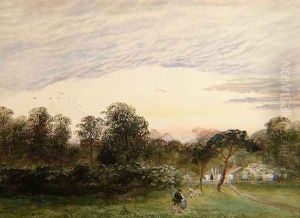Charles Frederick Williams Paintings
Charles Frederick Williams, a British artist known primarily for his landscape paintings, was born in 1832. Throughout his life, he developed a distinctive style that captured the British countryside with a romantic and often idyllic flavor. Williams's work is characteristic of the Victorian era, during which there was a significant interest in nature and the pastoral scenes of rural life.
Williams received his artistic training in London, where he was exposed to the works of the Old Masters, as well as the contemporary art movements of his time. Despite the growing influence of Impressionism towards the latter half of the 19th century, Williams remained largely faithful to the traditional approaches of landscape painting, emphasizing detail, balanced composition, and a harmonious color palette.
Not much is widely known about Williams's personal life or his career's specifics, as he did not gain the same level of fame as some of his contemporaries. Nevertheless, his paintings did enjoy recognition and were exhibited at various institutions, including the Royal Academy in London. Williams's landscapes often featured the English countryside and were noted for their tranquility and the artist's skillful rendering of different times of day and seasons.
Charles Frederick Williams continued to paint throughout his life and contributed to the artistic depiction of the British landscape during the Victorian period. His works, although not groundbreaking in terms of style or technique, have been appreciated for their serene beauty and craftsmanship. Williams passed away in 1904, leaving behind a body of work that continues to be appreciated by art lovers and collectors who have an affinity for traditional landscapes.
